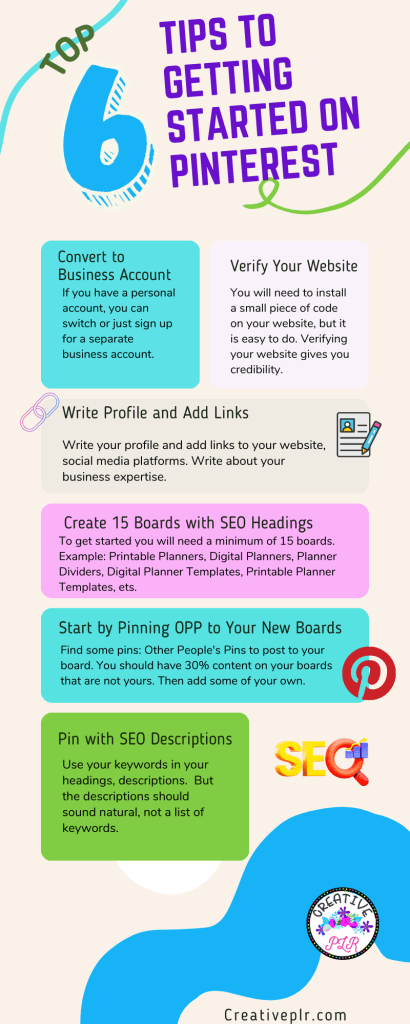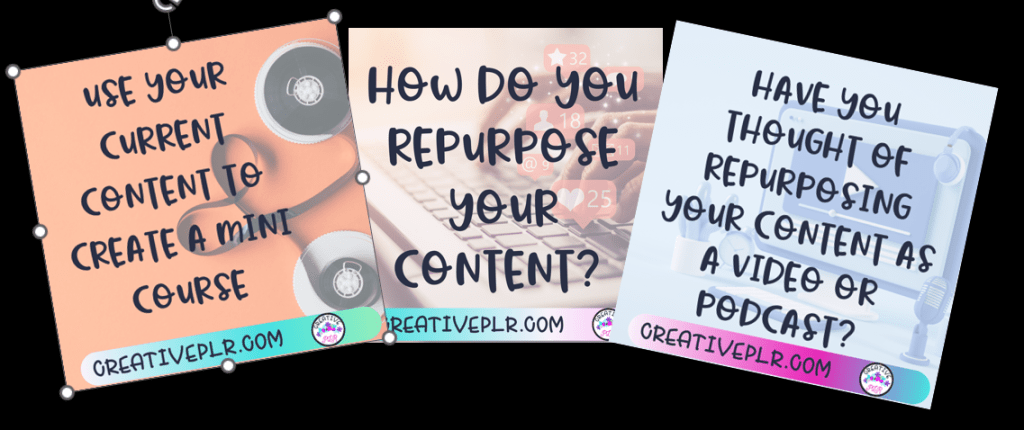If you don’t repurpose content, you are working too hard. While creating content is important, constantly churning out new content can be time-consuming and exhausting. That’s where leaning to repurpose content comes in. The content you already have can be redesigned and reworked into different forms.

And if like me, you buy and hoard PLR, then you will want to repurpose PLR content as well. Most PLR bundle packs include PLR articles, blog posts, checklists and sometimes audio content. These different formats make it even easier to repurpose content in different ways.
If your content is blogs, consider that 45% of the population in the U.S. prefers to watch the nightly news rather than read the newspaper. Many people like to listen while doing other things, so a podcast or offering an audio format would be attractive. And others like to watch video. Repurpose content to engage different parts of your audience and provide them the option of enjoying your content in the form they like.
I know I like explainer videos that show me the steps of something I am trying the first time. And I listen to audio books and podcasts while I am driving. Yes, I still read a lot, but being able to choose the type of content gives me and your audience more options.
1. Transforming Blog Posts into Engaging Videos
The easiest way to repurpose content is by transforming your blog posts into engaging videos. Blog content that has been popular will be popular in a new format. Videos have become increasingly popular, and they offer a dynamic and visually appealing way to convey information to your audience. Here’s how you can do it:

- Identify your most popular blog posts that have the potential to be transformed into videos.
- Create a script based on the key points and main takeaways from your blog post.
- Use high-quality visuals, such as images, graphs, or diagrams, to enhance the video’s visual appeal.
- Incorporate animations or motion graphics to make the video more engaging.
- Optimize the video’s title, description, and tags with relevant keywords to improve its searchability.
2. Creating Informative Infographics from Data-Rich Content
If you have data-rich content, such as research findings, case studies, or industry statistics, repurpose content into visually appealing infographics can captivate your audience. Infographics are highly shareable and can attract backlinks, thereby boosting your website’s visibility.
You can also use original content and present a “How to …” infographic in your own works. It is the perfect way to introduce a visual into the original blog and repurpose it into social media platforms. Follow these steps to create compelling infographics:

- Identify the most data-driven and informative sections of your content.
- Choose a visually appealing template or hire a professional designer to create a custom design.
- Present the data in a clear and concise manner, using charts, graphs, icons, and illustrations.
- Incorporate your branding elements, such as logos and colors, to maintain consistency.
- Optimize the infographic’s title, alt tags, and description with relevant keywords for better search engine visibility.
3. Crafting Comprehensive E-Books from Existing Content
Repurpose content into comprehensive e-books can establish you as an authority in your niche and generate valuable leads. The best part is that it takes just minutes to take your own products or private label content and use software to create an EBook. The advantage to an EBook is that users can access on a device to read (something that more people are doing) and you can also use PLR EBooks to revise and repurpose.

Here’s a step-by-step process to create compelling e-books:
- Identify a series of related blog posts or articles that can be compiled into an e-book.
- Rearrange the content into a logical order, ensuring a smooth flow from one topic to another.
- Add additional insights, case studies, or practical examples to enrich the content.
- Design an appealing cover and layout for the e-book to enhance its visual appeal.
- Optimize the e-book’s title, meta tags, and description with relevant keywords to improve its discoverability.
You can upload your PDF into Canva and create and EBook this way or use DESIGNRR. DESIGNRR also creates flip books which are useful on planner sales pages.
4. Repackaging Content into Engaging Podcast Episodes
Podcasts have gained tremendous popularity, providing a convenient way for audiences to consume content while on the go. Learning to repurpose content into podcast episodes can expand your reach and attract a new audience.

You can take video content that you already have and repurpose the content by keeping the audio portion and create an audio book. Add the audio to your original blog post for those who wish to listeN. Or save the audio book and use as a podcast. Here’s how to do it effectively:
- Identify blog posts or articles that can be transformed into podcast episodes.
- Adapt the content into a conversational script suitable for an audio format.
- Ensure high-quality audio production, including clear narration, appropriate background music, and sound effects.
- Optimize the podcast episode’s title, description, and tags with relevant keywords to improve its discoverability.
- You can also use a video that you already have and strip the audio from it with a program like Audiate.
5. Developing Interactive Webinars from Existing Content
Webinars offer an excellent opportunity to engage with your audience in real-time and provide valuable insights. You can repurpose content into interactive webinars and establish yourself as an industry expert as well as foster meaningful connections. Here’s how to create compelling webinars:

- Identify content that can be transformed into an engaging webinar format.
- Organize the content into sections and develop interactive elements, such as polls, Q&A sessions, and downloadable resources.
- Prepare visually appealing slides or visuals to support your presentation.
- Promote the webinar through your website, social media channels, and email newsletters.
- Optimize the webinar’s title, description, and landing page with relevant keywords to maximize its visibility.
6. Designing Engaging Slide Decks for Presentations
Repurpose content into visually appealing slide decks can be an excellent way to deliver powerful presentations and share valuable information with your audience. If you create a training or already offer a video, this can be a content upgrade as well. Follow these steps to create compelling slide decks:
- Identify the key points and main takeaways from your content.
- Organize the information into a logical flow and create individual slides for each point.
- Use eye-catching visuals, such as images, graphs, or diagrams, to support your content.
- Keep the text concise and use bullet points or short phrases to maintain clarity.
- Optimize the slide deck’s title, description, and tags with relevant keywords for improved search visibility.
7. Crafting Informative Email Newsletters
Repurpose content into informative email newsletters allows you to engage with your subscribers regularly and provide them with valuable insights. Here’s how you can repurpose your content for newsletters:

- Select relevant sections from your existing blog posts, articles, or e-books.
- Adapt the content to fit the newsletter format, focusing on concise and actionable information.
- Use attention-grabbing subject lines to entice readers to open your newsletters.
- Incorporate visuals, such as images or infographics, to enhance the visual appeal of your newsletters.
- Include links to the full content on your website to drive traffic and encourage further engagement.
8. Creating Micro-Content for Social Media
Micro-content refers to bite-sized pieces of content that are easily consumed on social media platforms. Repurposing your existing content into micro-content allows you to increase your social media presence and engage with your audience effectively. Extract the main points from an article or video content.
Consider the following approaches:

- Extract key quotes, statistics, or interesting facts from your blog posts, e-books, or videos.
- Design visually appealing graphics or images using tools like Canva or Adobe Spark.
- Create short and catchy captions that encapsulate the essence of your content.
- Include relevant hashtags and encourage social media users to share your micro-content.
9. Developing Interactive Quizzes and Assessments
Transforming your content into interactive quizzes or assessments can not only engage your audience but also provide valuable insights and personalized recommendations. It is an easy way to repurpose content and engage readers. Follow these steps to create interactive quizzes:
- Identify sections of your content that can be turned into quiz questions or assessments.
- Utilize online platforms like Typeform or SurveyMonkey to create interactive quizzes.
- Design visually appealing interfaces and include engaging visuals to enhance the user experience.
- Provide personalized results or recommendations based on the user’s responses.
- Optimize the quiz or assessment title, description, and landing page with relevant keywords.
10. Hosting Live Webinars and Q&A Sessions to Repurpose Content
In addition to repurposing content into pre-recorded webinars, hosting live webinars and Q&A sessions can create a sense of immediacy and encourage real-time interaction with your audience. Consider the following steps:
- Select a topic based on your existing content that is relevant and likely to generate interest.
- Promote the live webinar through your website, social media channels, and email newsletters.
- Encourage participants to ask questions or submit topics for discussion during the session.
- Provide valuable insights, share practical examples, and offer expert advice during the live session.
- Record the webinar and repurpose it as on-demand content for those who couldn’t attend live.
By leveraging these additional content repurposing strategies, you can expand your reach, engage with your audience on various platforms. Time to get those PLR bundles out and repurpose plr products as well as your own content in new fun ways instead of letting them gather digital dust.
Remember, repurposing content not only saves you time and effort but also allows you to establish a strong online presence. No matter what type of content you have, you can easily repurpose it into a different type of content in your own words. On any piece of content, it is important to consider your target audience and how they will engage with the content.